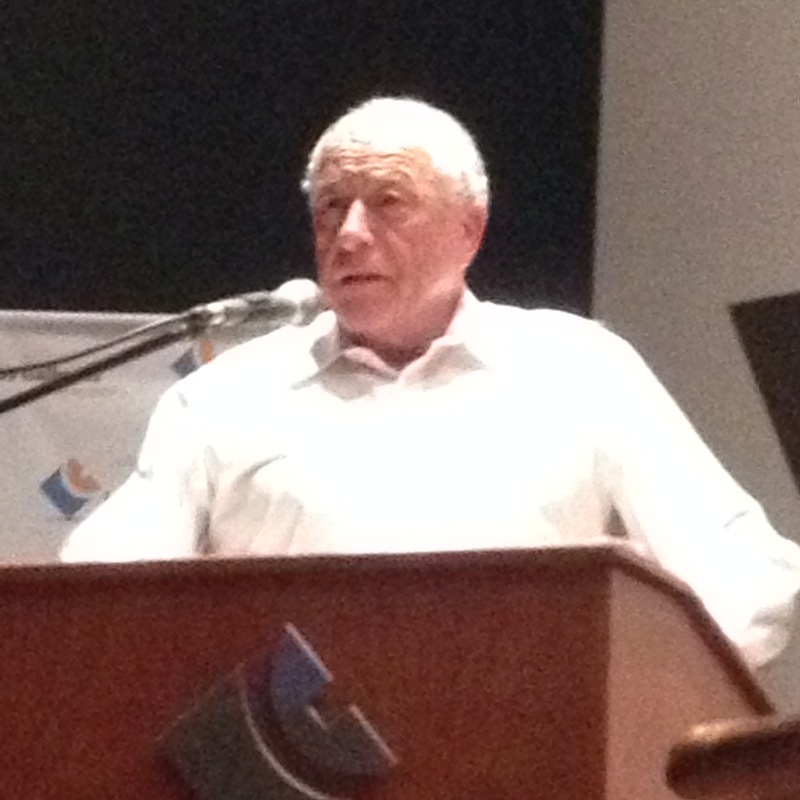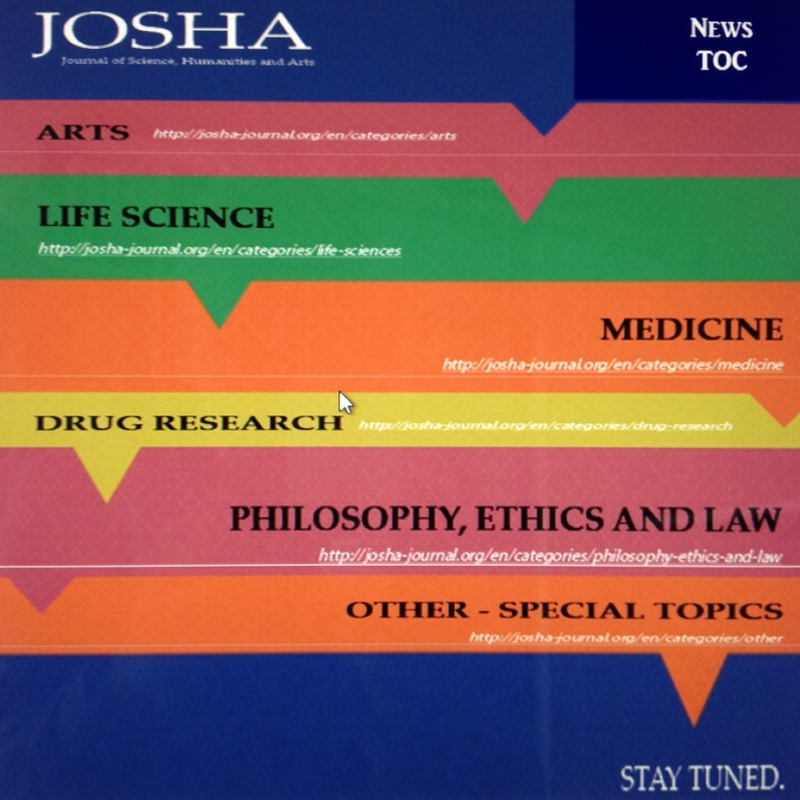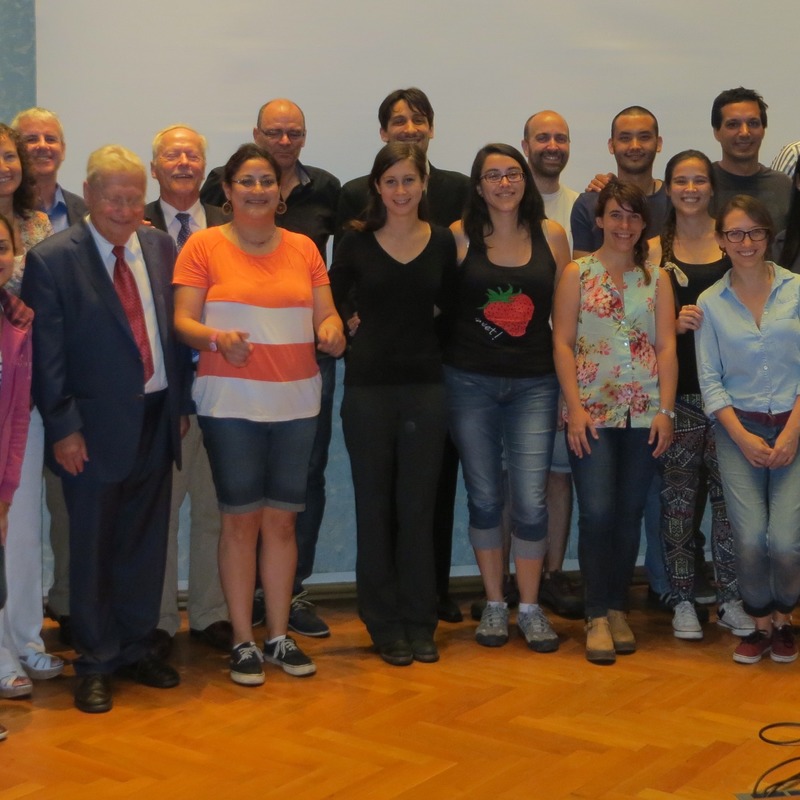Search
JOSHA - Table of Contents Volume 2 Issue 7
DOI: 10.17160/josha.2.7.85
Six contributions to JOSHA’s Issue 7 of Volume 2 complete the year 2015, the first whole Year of JOSHA’s service to provide a novel open access internet platform to facilitate entrée to the broad diversity of important discoveries and creativity in the fields of Science, Humanities and Arts. JOSHA’s last Issue of 2015 presents again attractions and highlights. The inspiring reading list of Nobel prize laureate Kurt Wüthrich introduces into the three spatial dimensions of biological macromolecules as identified by the technique of nuclear magnetic resonance (NMR) spectroscopy. Six fascinating paintings of French painter Albane Roux open senses for gestural dynamics in a colorful world, as art critic Christian Malaurie points out: “La peinture d’Albane Roux est une respiration, un mouvement qui invite le spectateur à un voyage intérieur ouvert sur le monde.
The NMR View of Proteins
DOI: 10.17160/josha.2.7.84
Nobel Prize laureate Kurt Wüthrich is the Cecil H. and Ida M. Green Professor of Structural Biology at The Scripps Research Institute, La Jolla, CA, USA, and Professor of Biophysics at the ETH Zürich, Zürich, Switzerland. He also directs research groups at the Universidad Federal do Rio de Janeiro in Brazil and at the iHuman Institute of ShanghaiTech University in China. His research interests are in molecular structural biology and structural genomics. His specialty is nuclear magnetic resonance (NMR) spectroscopy with biological macromolecules, where he contributed the NMR method of three-dimensional structure determination of proteins and nucleic acids in solution. The Wüthrich groups have determined a large number of macromolecular NMR structures, including the immunosuppression system cyclophilin A–cyclosporin A, the homeodomain–operator DNA transcriptional regulatory system, and prion proteins from humans, cattle and a variety of other species.
Post-Trial Obligations in the Declaration of Helsinki 2013, 1st Revision
DOI: 10.17160/josha.2.7.73
This presentation by Dr. Mastroleo is Revision 1 of the previously published version of September 6, 2015 (DOI: 10.17160/josha.2.6.65) Dr. Ignacio Mastroleo works on human health research ethics. Since Feb 2015 he is a member of the Post-Trial Responsibilities Workgroup of the Multi-Regional Clinical Trial (MRCT) Center, at Harvard University. He has a PhD in Philosophy from the University of Buenos Aires and Assistant Researcher at CONICET (National Scientific and Technical Research Council of Argentina) working at the Bioethics Program of FLACSO Argentina with his advisor, Dr. Florencia Luna. He was member of the research ethics committee at the Oncology Institute of the University of Buenos Aires.
JOSHA - Table of Contents Volume 2 Issue 6
DOI: 10.17160/josha.2.6.72
We are happy to present to you the Table of Contents for the next issue 2.6, with a number of articles and presentations by “bright minds at work”. Two artists are sharing their work and ideas with us, Jürgen Meyer-Isenmann with art on leather and wood, artistically transforming part of our industrial history. Dörte Oppermann presents a wonderful, unique description of her dreams in a series of poems and impressive paintings. A fascinating reading list on The Bayes Approach in Medical Statistics by Gerhard Nehmiz addresses the most important literature on the impact of Bayes' theorem on design and analysis of clinical trials. In probability theory and statistics, Bayes' theorem (alternatively Bayes' law or Bayes' rule, see also Wikipedia)) describes the probability of an event, based on conditions that might be related to the event.
The Bayes Approach in Medical Statistics
DOI: 10.17160/josha.2.6.68
Dr. Gerhard Nehmiz, Biberach, Germany, presents four reading lists on the Bayes approach in Medical Statistics - (1) References that had, from his subjective point view, historically the highest impact on the subject, (2) References that had the highest influence on his own thinking about the subject, (3) References to start with for a person with mathematical background, and (4) References to start with for a person with a medical or biological background. G.N. was born in 1955. He achieved the diploma in Mathematics in 1981 and the doctorate in Biostatistics in 1988. He is working as a biometrician for Boehringer Ingelheim since 1986. The main areas of his expertise include: Phase I trials in general, phase II and III trials in cardiovascular indications and hepatitis C. His special interest is project planning (extrapolation, optimization) based on uncertain knowledge. G.N. is married and has 3 adult children. Contact: gerhard.nehmiz.ext@boehringer-ingelheim.com
Post-Trial Obligations in the Declaration of Helsinki 2013
DOI: 10.17160/josha.2.6.65
Dr. Ignacio Mastroleo works on human health research ethics. Since Feb 2015 he is a member of the Post-Trial Responsibilities Workgroup of the Multi-Regional Clinical Trial (MRCT) Center, at Harvard University. He has a PhD in Philosophy from the University of Buenos Aires and Assistant Researcher at CONICET (National Scientific and Technical Research Council of Argentina) working at the Bioethics Program of FLACSO Argentina with his advisor, Dr. Florencia Luna. He was member of the research ethics committee at the Oncology Institute of the University of Buenos Aires. Last year he was awarded the Caroline Miles Scholarship of the Ethox Centre, Oxford University, UK and The Manuel Velasco Suarez Award for Excellence in Bioethics, by the Pan American Health Organization (PAHO) and the PAHO Foundation. In this presentation Dr. Mastroleone addresses the obligations of reserachers and clinicians after the formal clinical trial is completed.
Informed Consent in Genomic Research: The Iterative Feedback Model
DOI: 10.17160/josha.2.6.64
Recently, there has been a discussion on the best way to implement informed consent for the disclosure of incidental findings in research using whole genome sequencing (WGS)/whole exome sequencing (WES) procedures. Appelbaum et al. (2014:29) present four different “prototypical models” for the return of incidental findings, drawing on a literature review on return of incidental findings, a survey of a large number of genomic researchers and in-depth interviews with researchers and genomic research participants. I agree with Appelbaum et al. (2014) that consent models could be evaluated with the ethical criterion of “consistency with researchers’ ethical obligations” which is based on the ethical principles “respect for persons, beneficence, and justice” stated in the Belmont Report (1979). However, I propose to draw a different conclusion than Appelbaum et al. from this ethical evaluation. Appelbaum et al.
Genome Sequencing in Cancer Research and Therapy
DOI: 10.17160/josha.2.6.63
Stefan Fröhling has a long-standing interest in identifying genetic abnormalities that define disease subgroups and treatment outcome in patients with acute myeloid leukemia. Furthermore, he works to identify new cancer drug targets through a better understanding of the functional dependencies of hematologic and solid-organ malignancies, and to bring targeted approaches and molecularly based patient stratification to clinical trials and patient treatment broadly across tumor types.
The Scientific, Social and Ethical Aspects of Prolonging Human Life
DOI: 10.17160/josha.2.6.62
Professor Borner is a leading scientist in the field of apoptosis research. His career and activities include the following stations: 2014-present Director of the International Master Program in Medical and Biological Sciences (IMBS) between the Universities of Buenos Aires and Freiburg 2013-present Professor and Tutor in Biology, Psychology and Environmental Sciences for the Business and Administration study track of the California Miramar University (CMU) in Nairobi, Kenya (50% lectures, 50% online/e-learning tutoring).
Science, Ethics and Society: Introduction
DOI: 10.17160/josha.2.6.61
Roland Mertelsmann is a haematologist and oncologist and was professor and chairman at the Freiburg University Medical Center, Department of Oncology and Hematology. Amongst others, Roland Mertelsmann is known for his scientific work in the fields of hematology, oncology and stem cell transplantation. He started his career as a medical student at the Universities of Göttingen, Hamburg and the King’s College School of Medicine, London. After his graduation at the University of Hamburg, he contributed to the isolation of the blood stimulating growth factor G-SCF during his work in Hematology and Clinical Oncology at Memorial Sloan-Kettering Cancer Center in New York. In 1985, he returned to Germany and became professor and head of the Department for Hematology and Oncology at the University of Mainz and since 1989 at the University of Freiburg. In 1994 he founded the philanthropic Biothera Foundation, which supports education, research and training in the Biomedical Sciences.
.jpg?1451596416)




.jpg?1441465225)
.jpg?1441464437)
.jpg?1441463862)
.jpg?1441463149)
